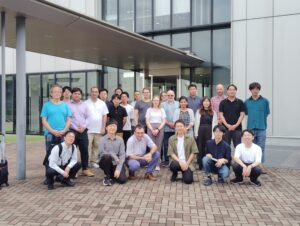
The Mini-Workshop on Particle-Based Cloud Modeling 2025 was held on 26 September 2025 at the University of Hyogo, Kobe, Japan, bringing together researchers from around the world to discuss the latest advances in cloud microphysics, aerosol–cloud interactions, and numerical modeling techniques. The workshop featured lively discussions on cutting-edge topics such as the Super-Droplet Method (SDM), bin and DNS simulations, freezing mechanisms, Lagrangian particle tracking, radar simulation, and the emerging use of quantum computing in atmospheric science. Participants emphasized the importance of integrating laboratory experiments, field observations, and numerical modeling to enhance understanding of cloud and precipitation processes.
The workshop consisted of three scientific sessions, each focusing on a distinct aspect of particle-based cloud modeling:
-
Session 1: Advances in droplet growth, aerosol sensitivity, and cloud organization through particle-based and high-resolution modeling.
-
Session 2: Bridging modeling frameworks, laboratory experiments, and observational tools to understand cloud processes across scales—from urban meteorology to planetary atmospheres.
-
Session 3: Exploring emerging frontiers in multiscale particle dynamics, next-generation computation, and interdisciplinary links between atmospheric and oceanic systems.
Session Highlights
The first session focused on advances in understanding droplet growth, aerosol sensitivity, and organized cloud structures using particle-based modeling. Discussions provided new insights into eddy-hopping mechanisms that broaden droplet spectra under pristine versus polluted conditions. A Lagrangian particle-tracking framework was introduced to improve SDM-based lifecycle analyses, while simulations of cumulonimbus clouds revealed the sensitivity of liquid water path and precipitation to aerosol loading. Typhoon environment simulations demonstrated the influence of cloud-condensation nuclei on cloud development and updraft dynamics. The session also featured studies on line-shaped converging precipitation systems across DNS, LES, and mesoscale simulations, and experimental progress in holographic particle tracking, which connected laboratory collision measurements with model parameterizations.
The second session emphasized the integration of modeling, laboratory validation, and remote-sensing analysis to develop unified microphysical representations. Presentations on the City-LES model highlighted advances in urban meteorology, simulating mist dispersion, heat stress mitigation, and shallow cumulus formation at building-resolving scales. A model intercomparison study of mixed-phase clouds underscored how grid resolution and microphysical schemes influence glaciation rates, while convection chamber simulations demonstrated the effect of aerosol concentration on droplet vertical structure. Expanding beyond Earth, discussions on Venus’s sulfuric acid clouds linked bifurcation dynamics to satellite observations. Presentations on immersion and homogeneous freezing stressed the advantages of time-dependent probabilistic models for capturing atmospheric variability. The session concluded with progress on radar simulator applications for SDM, showing how BIN-type data improve agreement between modeled and observed hydrometeors.
The final session explored multiscale particle dynamics, advanced freezing processes, and interdisciplinary modeling innovations. High-resolution DNS studies revealed inertial clustering of droplets across turbulent scales, while bimodal raindrop size distribution analyses demonstrated the dual influence of collision–coalescence and breakup on rainfall formation. A new two-stage freezing model was introduced to distinguish wet and dry growth in riming, enhancing the representation of mixed-phase clouds. Cutting-edge research on quantum computing for stochastic cloud processes highlighted its long-term potential despite high computational costs. The session concluded with an interdisciplinary study on the ocean biological carbon pump, emphasizing the critical role of particle processes in global carbon sequestration and climate modeling.
In summary, the Mini-Workshop on Particle-Based Cloud Modeling 2025 provided a valuable platform for exchanging ideas and fostering collaboration among atmospheric scientists, model developers, and experimentalists. The discussions reinforced the importance of integrating computational advances, laboratory validation, and observational data to build next-generation particle-based modeling frameworks for both Earth and planetary atmospheres.
The seminar attracted over 60 participants, both on-site and online. We sincerely thank all presenters for their insightful contributions and for sharing their expertise.
Keywords: Particle-based cloud modeling, Cloud microphysics, Large-eddy simulations (LES), Direct numerical simulation (DNS), Turbulence